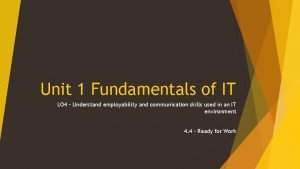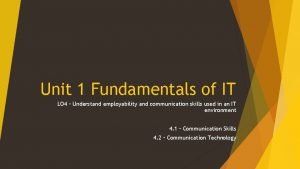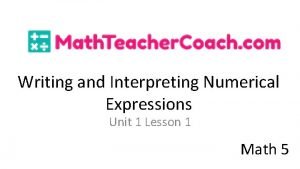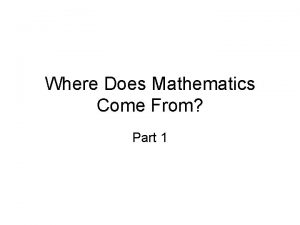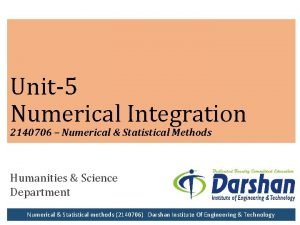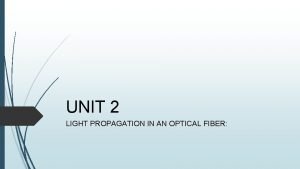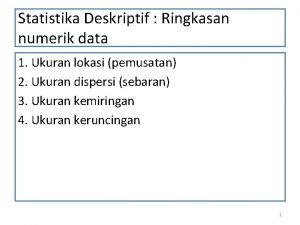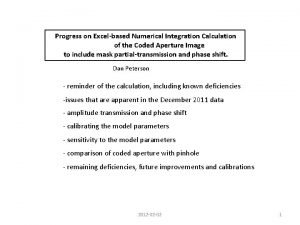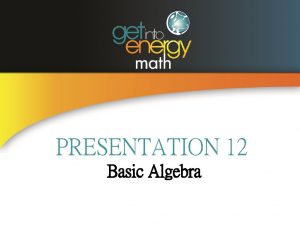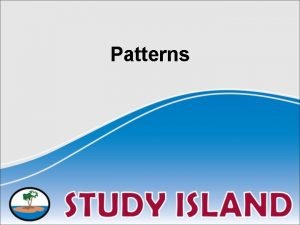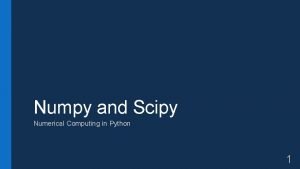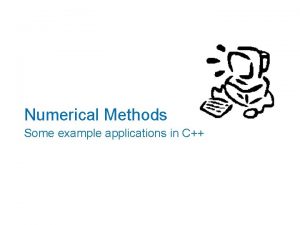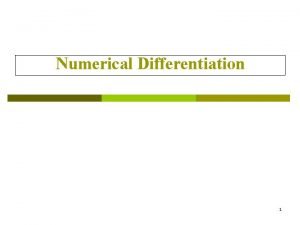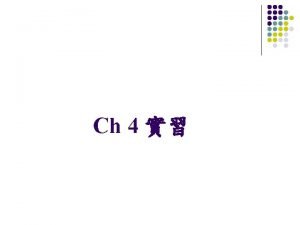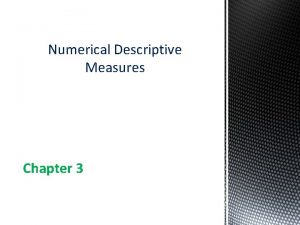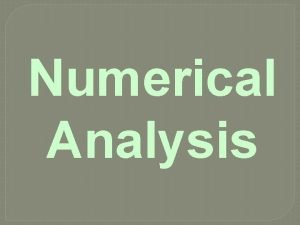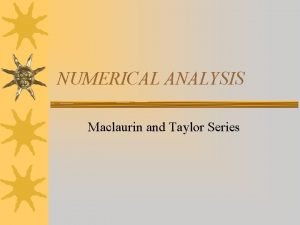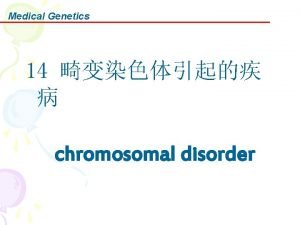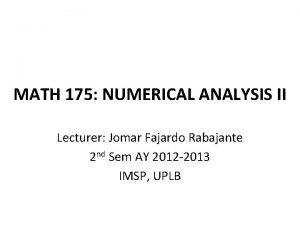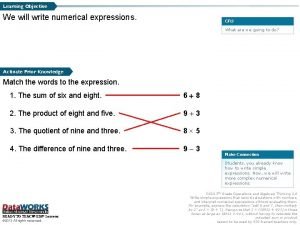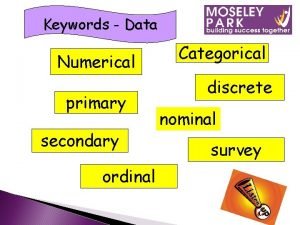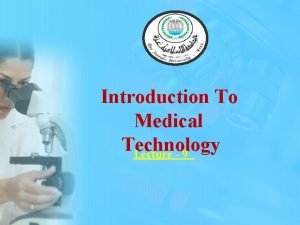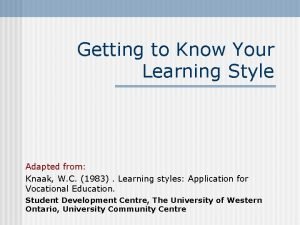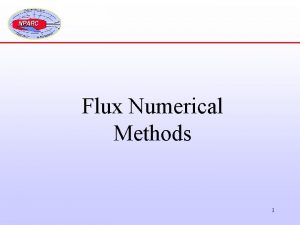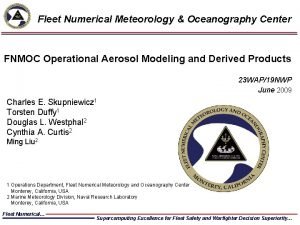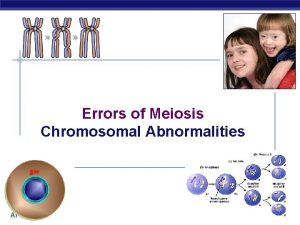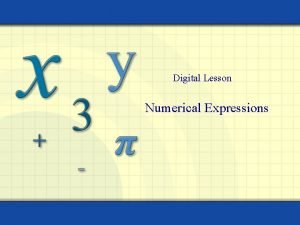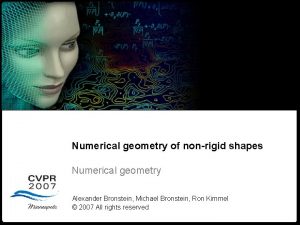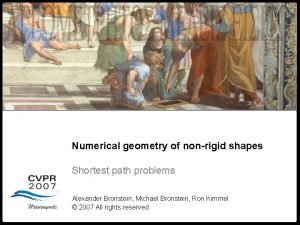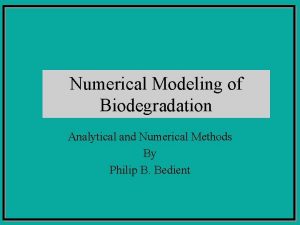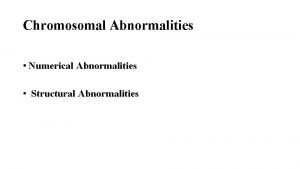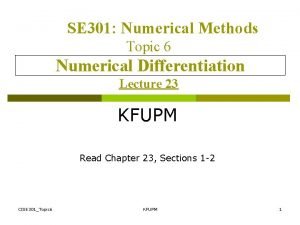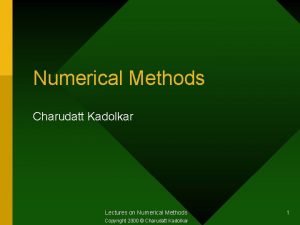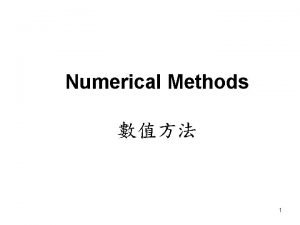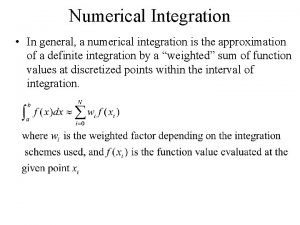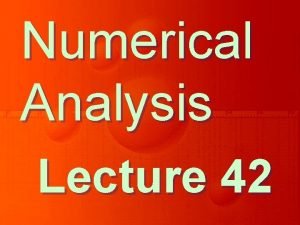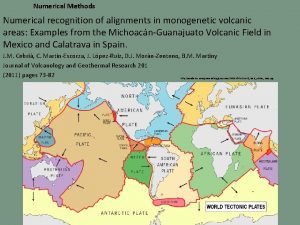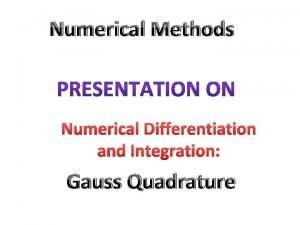Unit 5 Numerical Control Sections 1 Fundamentals of






























- Slides: 30

Unit 5 Numerical Control Sections: 1. Fundamentals of NC Technology 2. Computer Numerical Control 3. Distributed Numerical Control 4. Applications of NC 5. NC Part Programming

Numerical Control (NC) Defined Programmable automation in which the mechanical actions of a ‘machine tool’ are controlled by a program containing coded alphanumeric data that represents relative positions between a work head (e. g. , cutting tool) and a work part Program Instructions Transformati on Process Machine Control Unit Power



NC Coordinate Systems For flat and prismatic (block-like) parts: § Milling and drilling operations § Conventional Cartesian coordinate system § Rotational axes about each linear axis For rotational parts: § Turning operations § Only x- and z-axes

Motion Control Systems Point-to-Point systems § Also called position systems § System moves to a location and performs an operation at that location (e. g. , drilling) § Also applicable in robotics Continuous path systems § Also called contouring systems in machining § System performs an operation during movement (e. g. , milling and turning)

Interpolation Methods 1. 2. 3. 4. Linear interpolation § Straight line between two points in space Circular interpolation § Circular arc defined by starting point, end point, center or radius, and direction Helical interpolation § Circular plus linear motion Parabolic and cubic interpolation § Free form curves using higher order equations

Absolute vs. Incremental Positioning Absolute positioning Move is: x = 40, y = 50 Incremental positioning Move is: x = 20, y = 30.

Computer Numerical Control (CNC) § § § § Storage of more than one part program Various forms of program input Program editing at the machine tool Fixed cycles and programming subroutines Interpolation Acceleration and deceleration computations Communications interface Diagnostics

Machine Control Unit

DNC § Direct numerical control (DNC) – control of multiple machine tools by a single (mainframe) computer through direct connection and in real time § 1960 s technology § Two way communication § Distributed numerical control (DNC) – network consisting of central computer connected to machine tool MCUs, which are CNC § Present technology § Two way communication

Distributed Numerical Control Central Computer NC Pgms Computer Network BTR Machine Control Unit Transformati on Process BTR Machine Control Unit

Applications of NC

NC Application Characteristics (Machining) § § § Batch and High Volume production Repeat and/or Repetitive orders Complex part geometries Mundane operations Many separate operations on one part

Cost-Benefits of NC Costs § High investment cost § High maintenance effort § Need for skilled programmers § High utilization required Benefits § Cycle time reduction § Nonproductive time reduction § Greater accuracy and repeatability § Lower scrap rates § Reduced parts inventory and floor space § Operator skill-level reduced

Precision

NC Part Programming 1. 2. 3. 4. Manual part programming Manual data input Computer-assisted part programming Part programming using CAD/CAM

Manual Part Programming Binary Coded Decimal System § Each of the ten digits in decimal system (0 -9) is coded with four-digit binary number § The binary numbers are added to give the value § BCD is compatible with 8 bits across tape format, the original storage medium for NC part programs § Eight bits can also be used for letters and symbols

Creating Instructions for NC § § § Bit - 0 or 1 = absence or presence of hole in the tape Character - row of bits across the tape Word - sequence of characters (e. g. , y-axis position) Block - collection of words to form one complete instruction Part program - sequence of instructions (blocks)

Block Format Organization of words within a block in NC part program § Also known as tape format because the original formats were designed for punched tape § Word address format - used on all modern CNC controllers § Uses a letter prefix to identify each type of word § Spaces to separate words within the block § Allows any order of words in a block § Words can be omitted if their values do not change from the previous block

Types of Words N - sequence number prefix G - preparatory words § Example: G 00 = PTP rapid traverse move X, Y, Z - prefixes for x, y, and z-axes F - feed rate prefix S - spindle speed T - tool selection M - miscellaneous command § Example: M 07 = turn cutting fluid on

Example: Word Address Format N 001 G 00 X 07000 Y 03000 M 03 N 002 Y 06000

Cutter Offset Cutter path must be offset from actual part outline by a distance equal to the cutter radius

Issues in Manual Part Programming § Adequate for simple jobs, e. g. , PTP drilling § Linear interpolation G 01 G 94 X 050. 0 Y 086. 5 Z 100. 0 F 40 S 800 § Circular interpolation G 02 G 17 X 088. 0 Y 040. 0 R 028. 0 F 30 § Cutter offset G 42 G 01 X 100. 0 Y 040. 0 D 05

Example

Manual Data Input § § § Machine operator does part programming at machine § Operator enters program by responding to prompts and questions by system § Monitor with graphics verifies tool path § Usually for relatively simple parts Ideal for small shop that cannot afford a part programming staff To minimize changeover time, system should allow programming of next job while current job is running

Computer-Assisted Part Programming § § § Write machine instructions using natural language type statements Statements translated into machine code of the MCU APT (Automatically Programmed Tool) Language

Sample Statements § Part is composed of basic geometric elements and mathematically defined surfaces § Examples of statements: P 4 = POINT/35, 90, 0 L 1 = LINE/P 1, P 2 C 1 = CIRCLE/CENTER, P 8, RADIUS, 30 § Tool path is sequence of points or connected line and arc segments § Point-to-Point command: GOTO/P 4 § Continuous path command: GOLFT/L 1, TANTO, C 1

NC Part Programming Using CAD/CAM

You. Tube § § § § CNC Milling CNC Punching CNC Adhesive Bonding CNC Drug Insertion CNC Bioprocessing CAD/CAM Etc.
 Unit 10, unit 10 review tests, unit 10 general test
Unit 10, unit 10 review tests, unit 10 general test Unit 1 fundamentals of it
Unit 1 fundamentals of it Unit 1 fundamental skills
Unit 1 fundamental skills Numerical expression
Numerical expression Numerical stroop
Numerical stroop Simpson's 3/8 rule
Simpson's 3/8 rule Numerical aperture of optical fiber
Numerical aperture of optical fiber Numerical description
Numerical description Non-numerical unstructured data indexing
Non-numerical unstructured data indexing Numerical integration excel
Numerical integration excel Numerical coefficient
Numerical coefficient Numerical patterns
Numerical patterns Graphical and numerical methods
Graphical and numerical methods Numerical computing with python
Numerical computing with python Numerical differentiation c++
Numerical differentiation c++ Numerical differentiation
Numerical differentiation What is the lower quartile measure of this box plot?
What is the lower quartile measure of this box plot? Numerical descriptive measures exercises
Numerical descriptive measures exercises Newton backward interpolation formula
Newton backward interpolation formula Taylor series numerical methods
Taylor series numerical methods Turner syndrome is what numerical chromosome disorder?
Turner syndrome is what numerical chromosome disorder? Numerical analysis formula
Numerical analysis formula Numerical aperture in microscope
Numerical aperture in microscope Numerical expression examples
Numerical expression examples What is numerical discrete
What is numerical discrete Numerical aperture in microscope
Numerical aperture in microscope Visual numerical learning style
Visual numerical learning style Numerical flux
Numerical flux Fnmoc meteorology products
Fnmoc meteorology products Turner syndrome is what numerical chromosome disorder?
Turner syndrome is what numerical chromosome disorder? Numerical expression examples
Numerical expression examples

